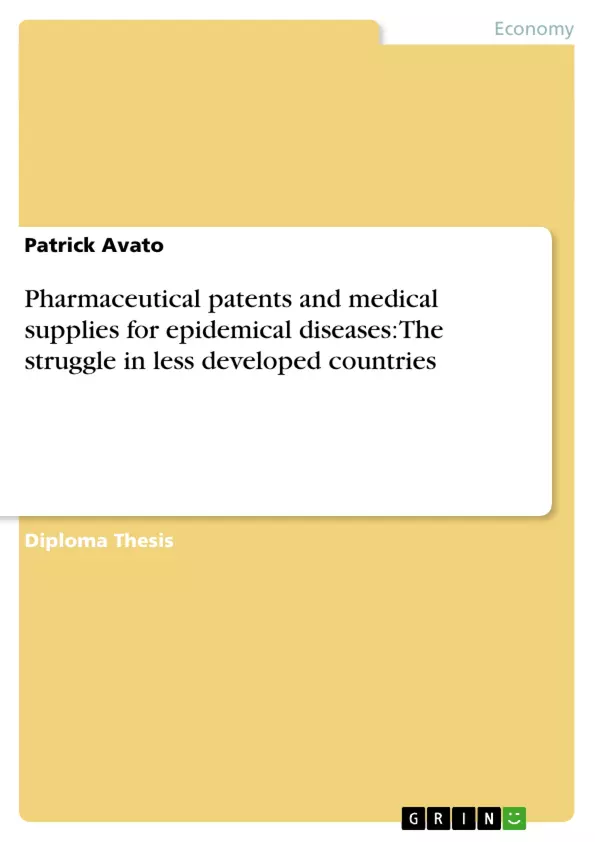The last century has been characterized by great advancements of pharmaceuticals and a worldwide rise of life expectancy. Improvements in medical research have yielded significant progress in treating diseases that only recently were deemed incurable. This is most obvious in the case of HIV/AIDS where considerable public and private investments have converted this killer into a manageable chronic disorder for many in the developed world. However, treatment is out of reach for almost 90 percent of the millions of infected people in the developing world. Tragically, AIDS is not the only pandemic threatening the developing world. Malaria and Tuberculosis are only the most prominent of a large number of epidemical diseases affecting the world’s poor. Overall, about ten million people die through infectious diseases each year, more than 90 percent of whom in the developing world. These people do not receive treatment for their diseases – either because they cannot afford treatment or because treatment for their diseases does not exist.
The following paper discusses these issues form an economic and institutional perspective, focusing on the most crucial aspects of pharmaceuticals in the developing world: the development of new pharmaceutical innovations and access to these products for the poor. In order to put the discussion into perspective, chapter 1 discusses the current situation of public health in LDCs and its problematic economic and social consequences. The situation is then confronted with the current state of intellectual property rights in international law. Chapter 3 introduces a discussion of the functioning and the theoretical justification of patents and their relation to the economics of pharmaceuticals. It will be shown how certain characteristics of pharmaceuticals and their production process make a political intervention necessary. However, as this policy instrument also causes considerable social costs, the trade off between these costs and benefits is thoroughly analyzed. Building on this framework, chapter 4 examines the potential effects of an international adoption of (TRIPS like) patents on the availability of drugs in LDCs. This analysis leads to certain conclusions, which form the foundation of the possible solutions to the dilemma presented in chapter 5. Chapter 6 concludes this study.
Inhaltsverzeichnis (Table of Contents)
- 1. Introduction
- 2. Pharmaceutical Patents and the Poor - The Point of Departure
- 2.1. Public Health and the Economy in LDCs
- 2.1.1. The Burden of Disease
- 2.1.2. The Economic Consequences of Poor Health
- 2.2. Intellectual Property Rights in Developing Countries
- 2.2.1 The TRIPS Agreement
- 2.2.2. Bilateral Trade Agreements
- 3. Patents and the Pharmaceutical Industry
- 3.1. The Economics of Pharmaceuticals
- 3.2. The Economics of Patents
- 3.3. Diffusion vs. Creation of Knowledge
- 4. Pharmaceutical Patents in LDCs
- 4.1. Static Effects
- 4.1.1. The Comparative Position of LDCs
- 4.1.2. Extent of Effects
- 4.2. Dynamic Effects
- 4.2.1. Domestic R&D Potential
- 4.2.2. Market Size
- 4.2.2.1. Global Diseases
- 4.2.2.2. Diseases of the Poor
- 4.2.2.3. Tropical Diseases
- 4.3. The curse of poverty
- 5. The Road Ahead
- 5.1. Price Discrimination
- 5.1.1. The Theoretical Framework
- 5.1.2. The Political Dimension of Differential Pricing
- 5.2. Public Intervention and the Role of Rich Countries
- 5.2.1. Modified Orphan Drug Acts
- 5.2.2. The Purchase Fund
- 5.2.3. Public-Private Partnerships (PPPs)
- 5.3. The Politics of Pharmaceutical Development Aid
- 5.4. Compulsory Licenses: The Option of Last Resort?
Zielsetzung und Themenschwerpunkte (Objectives and Key Themes)
This paper examines the complex relationship between pharmaceutical patents and the availability of medical supplies in less developed countries (LDCs). It aims to explore the economic and social implications of intellectual property rights (IPR) in the context of global health challenges. The work analyzes the impact of patents on drug prices and access to essential medicines, particularly for prevalent diseases in LDCs. Moreover, it delves into potential solutions and strategies to address the challenges faced by LDCs in securing affordable and accessible medicines.
- The burden of disease and economic consequences of poor health in LDCs
- The influence of intellectual property rights, including the TRIPS Agreement, on pharmaceutical access in developing countries
- The economic impact of patents on the pharmaceutical industry, including innovation and market dynamics
- The challenges faced by LDCs in accessing essential medicines due to patent protection, particularly in the context of prevalent diseases
- Potential solutions and policy interventions to address the challenges and promote affordable access to essential medicines in LDCs
Zusammenfassung der Kapitel (Chapter Summaries)
The first chapter introduces the topic of pharmaceutical patents and their impact on access to medicines in LDCs. It highlights the significance of this issue for public health and economic development. Chapter 2 delves into the specific context of LDCs, exploring the burden of disease and the economic consequences of poor health in these countries. It further examines the role of intellectual property rights, including the TRIPS agreement and bilateral trade agreements, in shaping access to medicines. Chapter 3 focuses on the pharmaceutical industry, exploring the economics of pharmaceuticals and patents, and the interplay between knowledge creation and diffusion. Chapter 4 examines the static and dynamic effects of pharmaceutical patents on LDCs, analyzing the comparative position of these countries and the extent of the impact. It explores the potential for domestic R&D and the influence of market size on drug availability.
Schlüsselwörter (Keywords)
Pharmaceutical patents, intellectual property rights, TRIPS agreement, public health, LDCs, developing countries, access to medicines, drug prices, disease burden, economic development, innovation, R&D, market dynamics, price discrimination, policy interventions, global health challenges, affordable medicines.
- Arbeit zitieren
- Patrick Avato (Autor:in), 2004, Pharmaceutical patents and medical supplies for epidemical diseases: The struggle in less developed countries, München, GRIN Verlag, https://www.grin.com/document/27002



